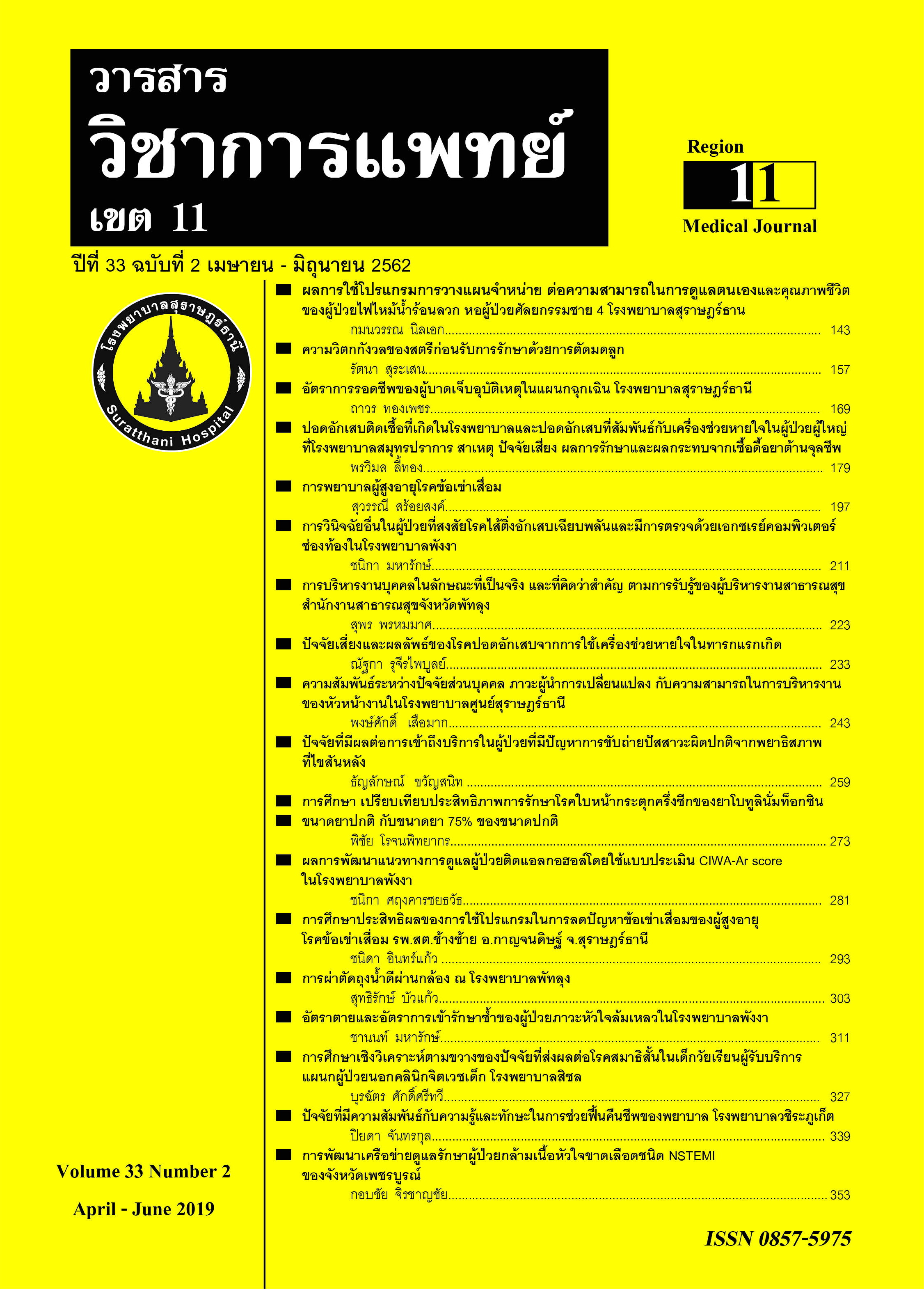Factors Related to Nurses’ Knowledge and Skills in Cardiopulmonary Resuscitation in Vachira Phuket Hospital.
Keywords:
knowledge and skill, cardiopulmonary resuscitation, nursesAbstract
This descriptive study aimed to explore nurses’ cardiopulmonary resuscitation (CPR) knowledge and skills and to examine the relationships among attending cardiopulmonary resuscitation training, current workplace and direct experience in performing or participating in cardiopulmonary resuscitation. Data collection was done with 317 nurses who attended the CPR training allocated at Vachira Phuket hospital. The questionnaires were used for collecting
data which composed of three parts: 1) Demographic data 2) Nurses’ CPR knowledge and 3) Nurses’ CPR skills. Data were analyzed using descriptive statistics and reference statistics including Pearson Product-Moment Correlation Coefficient and Chi-square.
The results revealed that almost all of the participants (94.3%) passed the nurses’ CPR knowledge was If enough oxygen to the brain, must be done within 4 minutes. Nurses’ ACBD CPR skills, the level of Assess nurses’ CPR skills was high ( = 3.62 ± 0.045 S.D.) the level of Circulation and Compression nurses’ CPR skills was medium ( = 3.53 ± 0.027 S.D.) the level of Airway and Breathing nurses’ CPR skills was medium ( = 3.50 ± 1.00 S.D.) and the level of Defibrillation nurses’ CPR skills was low. ( = 3.00 ± 0.160 S.D.) There were relationships among attending age, advanced CPR training, direct experience in performing or participating CPR, and current workplace, and nurses’ CPR knowledge and skills (r = 129, p-value = 0.022, r = 0.129, p-value = 0.021, r = 0.124, p-value =
0.036, r = 0.145, p-value = 0.010 respectively).
The research results showed that advanced CPR training sessions need to be located continuously in order to improve the quality of nurses’ CPR knowledge and skills.
References
the American Heart Association. Circulation;2013; 127 : e6-e245.
2. อุรา แสงเงิน. ปัจจัยที่มีความสัมพันธ์กับความรู้และทักษะในการช่วยฟื้นคืนชีพของพยาบาล โรงพยาบาลสงขลานครินทร์.วารสารพยาบาลสงขลานครินทร์ 2555;32(1):1-10
3. Kim, E. J., Lee, K. R., Lee, M. H., & Kim,J. Y. Nurses’ cardiopulmonary resus citation performance during the first 5 minutes in in-situ simulated cardiac arrest. Journal of Korean Academy of Nursing 2012;42 : 361-368.
4. พลพันธ์ บุญมาก, สุหัทยา บุญมาก, สมยงค์ ศรีชัยปัญหา และสุเจตนา ภูมิสวาสด. ความรู้และทักษะภายหลังการฝึกอบรมการช่วยฟื้นคืนชีพขั้นสูงระยะสั้น. Journal of the Medical Association of Thailand 2548; 87: 1311-1314.
5. บุษบา ประสารอธิคม. พัฒนารูปแบบการอบรมการช่วยฟื้นคืนชีพขั้นสูงสำหรับพยาบาลวิชาชีพงานผู้ป่วยหนักโรงพยาบาลอุดรธานี. วารสารพยาบาลศาสตร์ จุฬาลงกรณ์มหาวิทยาลัย 2560;
29 : 128 – 140.
6. กาญจนา วุฒิเจริญกิจ. ประสบการณ์การช่วยฟื้นคืนชีพของพยาบาลประจำการแผนกอุบัติเหตุและฉุกเฉิน. วิทยานิพนธ์พยาบาลศาสตรมหาบัณฑิต สาขาการพยาบาลผู้ใหญ่มหาวิทยาลัยบูรพา, ชลบุรี;2547.
7. American Heart Association Guidelines Update for Cardiopulmonary Resuscitation and Emergency Cardiovascular Care 2015.Circulation. 2015;132:S313-S314
8. ศิริอร สินธุ, รวมพร คงกำเนิด และ กุลระวี วิวัฒนชีวิน. การศึกษาปัจจัยที่มีความสัมพันธ์กับการปฏิบัติการการแพทย์ฉุกเฉินของพยาบาลวิชาชีพ. วารสารวิทยาลัยพยาบาลบรมราชชนนี นครราชสีมา; 2557
9. สุภามาศ ผาติประจักษ์. ความสัมพันธ์ระหว่างความรู้ การรับรู้สมรรถนะของตนเองในการปฏิบัติการช่วยฟื้นคืนชีพขั้นพื้นฐาน และความสามารถในการกดหน้าอก ในนักศึกษาพยาบาลระดับ
ปริญญาตรี. วารสารพยาบาลสงขลานครินทร์ 2558; 35 : 119 – 140.






